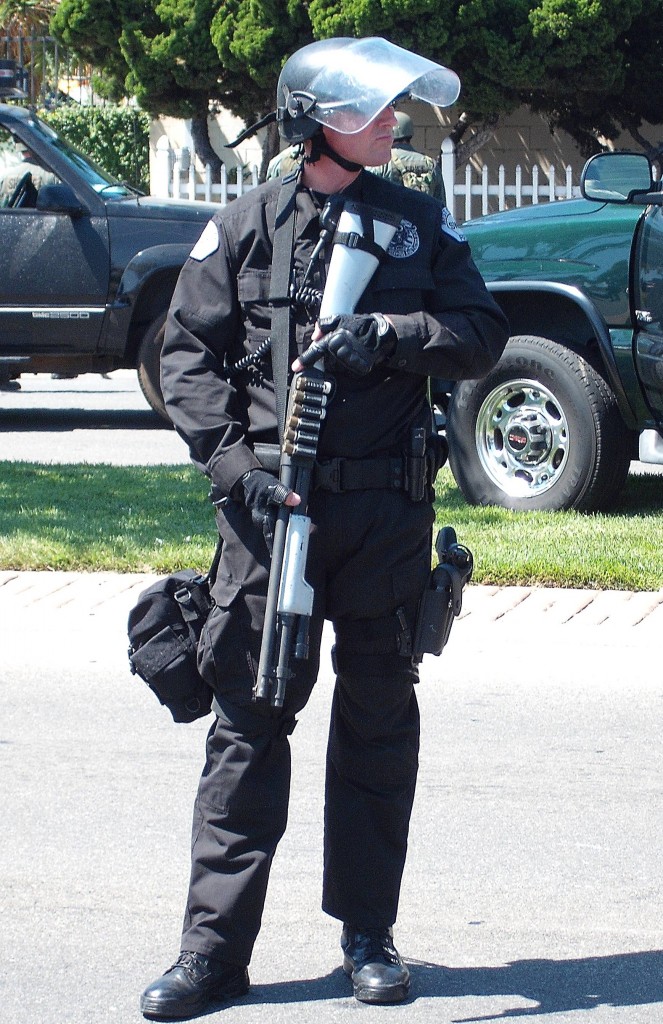KEEPING THE RABBLE IN LINE: A member of West County SWAT, a regional Special Weapons and Tactics Team serving the cities of Cypress, Los Alamitos, Westminster and Fountain Valley, maintains a watchful eye on “subversive groups” protesting along Ball Road in the City of Anaheim.
There has been quite a bit of chatter on the internet lately over the City of Anaheim’s intense response to the anti-police brutality demonstration that initially began in front of police headquarters last Sunday afternoon. Much of the discussions I’ve seen so far have focused on how militarized law enforcement has become in recent years, as if somehow this is a new phenomena in U.S. history. The truth is, it’s not. This trend actually started in the late 1960s after local police departments found themselves ill-equipped to deal with the “civil unrest” that was taking place during that era.
Many people don’t realize it, but quite a few officers running around Anaheim that day happened to be members of local Special Weapons and Tactics Teams, also known by its familiar acronym, SWAT. The concept behind SWAT first originated within the Los Angeles Police Department not long after the Watts rebellion of 1965. A police inspector by the name of Darryl F. Gates, who would later become Chief of Police, approved of the idea of establishing a “small group of highly disciplined officers” trained in the use of “special weapons and tactics” to deal with “dangerous situations.”
And what “dangerous situations” was SWAT specifically created to handle?
The LAPD website says it all:
The first Special Weapons and Tactics (SWAT) Unit consisted of 15 four-man teams. Members of each team, who volunteered from the ranks of patrol and other police assignments, had specialized experience and prior military service. Each unit was activated for monthly training or when the need for special weapons personnel actually arose. These units, known as “station defense teams,” provided security for police facilities during civil unrest.
In 1971, the SWAT personnel were assigned on a full-time basis to Metropolitan Division to respond to continuing action by subversive groups, the rising crime rate and the continuing difficulty of mustering a team response in a timely manner.
The first challenge to these pioneers in the field of special weapons and tactics came in 1969. On December 9th, search warrants for illegal weapons were served at the Black Panther Headquarters at 41st and Central Streets. The Black Panthers resisted and attempted to shoot it out with 40 members of the SWAT Team. In the ensuing four-hour siege, thousands of rounds of ammunition were fired, resulting in the wounding of three Panthers and three police officers. The Panthers finally surrendered to SWAT officers, whose first mission was now an indelible part of history.
Nobody should be surprised that SWAT teams were deployed on the streets of Anaheim since their intended historical purpose was to suppress “civil unrest” and wipe out “subversive groups” which posed a threat to the system. That they were called out enmass to confront a crowd of unarmed protesters, however, seems to be a bit of overkill, to say the least. An ominous precursor of things to come? A signal, perhaps, that the tiny handful rich people who own and control much of everything around here will do whatever they possibly can to maintain their power and privilege?








This begs the question: How are we going to police the police? They don’t even know why they are called to do what they are asked to do. Let’s educate them!
Armed to the teeth…
Ready to go to war…
Send this PIGS to Afghanistan!!!